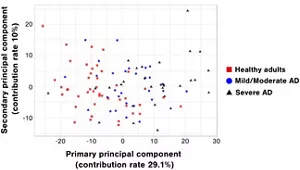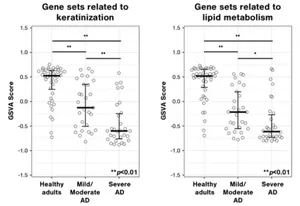Skin Surface Lipids (SSL) -RNA Monitoring Technology
Molecular Changes Depending on Disease Severity Found in SSL-RNA of Adult Atopic Dermatitis incl. Severe Cases
The research group at The Bioscience Laboratory of Kao Corporation and Maruho Co., Ltd. analyzed sebum collected from adult patients with atopic dermatitis (AD) including severe cases and found that the skin surface lipids-RNA (SSL-RNA)*1 contains molecules that change depending on the severity of the disease. This finding suggests the possibility of non-invasive and precise monitoring of a broader range of AD conditions, including severe cases, by analyzing SSL-RNA. This study was conducted in collaboration with Hidehisa Saeki, Graduate School Professor (Department of Cutaneous and Mucosal Pathophysiology, Graduate School of Medicine, Nippon Medical School), Takeshi Nakahara, Professor (Department of Clinical Medicine, Faculty of Medical Sciences, Kyushu University), Akio Tanaka, Professor (Department of Dermatology, Graduate School of Biomedical and Health Sciences [Medical], Hiroshima University), and Koji Masuda, Associate Professor (Department of Dermatology, Graduate School of Medicine, Kyoto Prefectural University of Medicine).
The results of this study were presented at the International Societies for Investigative Dermatology: ISID 2023 Meeting (May 10–13, 2023, Tokyo) by Dr. Akio Tanaka.
-
* 1 RNA extracted from sebum collected with an oil-blotting film (Skin Surface Lipids-RNA: SSL-RNA). Sebum is secreted from the sebaceous glands and plays a role in preventing evaporation of moisture.
Background
In AD treatment, it is essential to properly assess the severity of the disease in order to provide appropriate treatment for the symptoms of each patient. TARC (thymus and activation-regulated chemokine)*2 in blood is currently used as a diagnostic and severity marker of AD. However, the location of blood sampling is restricted and might induce pain in patients. Furthermore, it has been found that TARC may show unexpected values during the administration of therapeutic drugs for AD and thus may not correctly reflect the severity of AD. Therefore, a new technology to determine the severity of AD noninvasively, easily and accurately has been long awaited.
The SSL-RNA monitoring technology, which was reported by Kao in 2019*3 , allows the easy collection of RNA from facial sebum for analysis without damaging the skin. Kao has already reported that RNA expression profile in sebum reflects characteristics of adult and infant patients with AD*3 , although those studies were conducted in patients with mild-to-moderate AD. In actual clinical settings, however, techniques for determining the severity of patients with severe AD as well as those with mild/moderate AD are needed. In this collaborative study, Kao and Maruho took samples of sebum from patients with severe AD to identify characteristics of their SSL-RNA and factors that change depending on the severity of disease.
-
* 2 A molecule that could induces the inflammatory reaction of AD, the amount of which is believed to increase in a severity-dependent manner. TARC is used in blood tests as a diagnostic and severity marker of AD.
-
* 3 Kao news release, June 10, 2019:
Kao | Kao's original non-invasive analytical method for monitoring RNA - Discovery of the presence of human RNA in sebum
Kao news release, October 16, 2020:
Kao | Skin Surface Lipids-RNA Monitoring Technology : Changes Found in Skin Surface Lipids-RNA in Infants with Atopic Dermatitis
Kao news release, April 12, 2023.
Diagnosing Early-Onset Atopic Dermatitis using sebum (in Japanese)
Changes in SSL-RNA depending on the severity of AD
In order to examine whether the features related to the severity of AD is reflected in SSL-RNA, the research group took samples of SSL-RNA from healthy adults, patients with mild/moderate AD, and patients with severe AD, and then visualized the expression profile of representative RNA using principal component analysis*4 . In principal component analysis, data including similar characteristics are plotted in close proximity to each other. As a result, the healthy adults, the patients with mild/moderate AD, and the patients with severe AD were plotted in close proximity to the other sample in the same group, respectively (each group is represented by dots of the same color and shape). Meanwhile, the greater the severity of AD (from mild/moderate AD to severe AD), the larger the distance from the healthy adults (Figure 1).
This finding suggests that SSL-RNA expression profile reflects the severity of AD.
-
* 4 A method of statistical analysis that compresses information containing a huge number of variables (high dimensionality) and expresses it by a small number of composite variables (low dimensionality). In this analysis, the research group used data of the top 500 genes with greater variation in gene expression level. A single dot (■●▲) indicates the data of a single person.

Figure 1: Similarity in SSL-RNA expression profile in healthy adults, patients
with mild/moderate AD, and patients with severe AD
Furthermore, using GSVA (Gene Set Variation Analysis)*5, the research group scored expression levels of gene sets related to skin barrier function by sample (30 and 29 sets for cornification and lipid metabolism, respectively). The results demonstrated that the greater the severity of AD, the lower the score of each gene set (Figure 2). In addition, the SSL-RNA expression level of the CCL17 gene, which is considered particularly related to AD, was found to increase in a stepwise manner as the severity of AD increased.
The above findings demonstrated that some molecules that change depending on the severity of AD are closely related to the pathological conditions of AD, suggesting the possibility of assessing severity ranging from mild AD to severe AD by using SSL-RNA monitoring technology.
-
* 5 A method of scoring an expression level of a given gene set of a sample (e.g., a group of genes related to a particular function) in comparison to other samples.

Figure 2: Change in GSVA score for AD-related gene sets with severity of AD
Conclusion
The research group found that SSL-RNA contains molecules that change depending on the severity of AD in adult patients with not only mild/moderate AD but also severe AD. Taking into account previous reports, SSL-RNA has the potential to monitor AD conditions precisely, easily, and without damaging the skin. This technology might help to find an optimal treatment method for each patient.
Utilizing the SSL-RNA analytical method, Kao and Maruho will continue their research in order to establish a new assessment method for adult AD patients.
About Kao Corporation
Kao Corporation operates its consumer product business consisting of Hygiene and Living Care, Health and Beauty Care, Life Care, and Cosmetics, as well as its Chemical Business to meet the various needs of industry. For the purpose of “creating a sustainable world where all life can coexist and flourish,” Kao has been carrying out its Mid-term Plan (K25) under the vision of “Sustainability as the only path” since 2021. Please visit the Kao Group website for updated information.
About Maruho Co., Ltd.
Maruho Co., Ltd. is a pharmaceutical company engaged in research, development, manufacturing, and sales of ethical pharmaceuticals and other products. With the mission “More smiles, brighter life for you,” Maruho aims to realize a society where everyone can live with a smile on their face. For more information about Maruho Co., Ltd., please visit the company website.
Media inquiries should be directed to:
Public Relations
Kao Corporation
